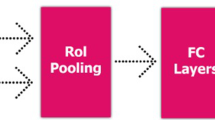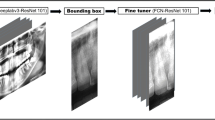Abstract
Objectives
Artificial intelligence (AI) techniques like convolutional neural network (CNN) are a promising breakthrough that can help clinicians analyze medical imaging, diagnose taurodontism, and make therapeutic decisions. The purpose of the study is to develop and evaluate the function of CNN-based AI model to diagnose teeth with taurodontism in panoramic radiography.
Methods
434 anonymized, mixed-sized panoramic radiography images over the age of 13 years were used to develop automatic taurodont tooth segmentation models using a Pytorch implemented U-Net model. Datasets were split into train, validation, and test groups of both normal and masked images. The data augmentation method was applied to images of trainings and validation groups with vertical flip images, horizontal flip images, and both flip images. The Confusion Matrix was used to determine the model performance.
Results
Among the 43 test group images with 126 labels, there were 109 true positives, 29 false positives, and 17 false negatives. The sensitivity, precision, and F1-score values of taurodont tooth segmentation were 0.8650, 0.7898, and 0.8257, respectively.
Conclusions
CNN’s ability to identify taurodontism produced almost identical results to the labeled training data, and the CNN system achieved close to the expert level results in its ability to detect the taurodontism of teeth.





Similar content being viewed by others
References
Weckwerth GM, Santos CF, Brozoski DT, Pagin CBS, O, Lauris JRP, et al. Taurodontism, root dilaceration, and tooth transposition: a radiographic study of a population with nonsyndromic cleft lip and/or palate. Cleft Palate Cranio-fac J. 2016;53:404–12.
Topal BG, Tiras M. Developmental anomalies affecting tooth roots. Dent Med J-R. 2020;2:111–26.
Manjunatha B, Kovvuru SK. Taurodontism: a review on its etiology, prevalence and clinical considerations. J Clin Exp Dent. 2010;2:1–5.
Jafarzadeh H, Azarpazhooh A, Mayhall JT. Taurodontism: a review of the condition and endodontic treatment challenges. Int Endod J. 2008;41:375–88.
Bronoosh P, Haghnegahdar A, Dehbozorgi M. Prevalence of taurodontism in premolars and molars in the South of Iran. J Dent Res Dent Clin Dent Prospects. 2012;6:21–4.
Umar E, Altun O, Dedeoglu N. The retrospectıve evaluation of taurodontism prevalence in patiens admitting Inonu Univercity Faculty of Dentistry. Cumhur Dent J. 2014;17:235–43.
Nalcacı R, Gorgun S, Karakaya M. Incidence of taurodontism in Turkish population. Turkiye Klinikleri J Dent Sci. 2000;6:178–82.
White SC, Pharoah MJ. Oral radiology-e-book: principles and interpretation. 5th ed. St. Louis, USA: Mosby; 2004.
Luan X, Ito Y, Diekwisch TGH. Evolution and development of Hertwig’s epithelial root sheath. Dev Dyn. 2006;235:1167–80.
Schwendicke FA, Samek W, Krois J. Artificial intelligence in dentistry: chances and challenges. J Dent Res. 2020;99:769–74.
Kim DH, MacKinnon T. Artificial intelligence in fracture detection: transfer learning from deep convolutional neural networks. Clin Radiol. 2018;73:439–45.
Kurt Bayrakdar S, Celik O, Bayrakdar IS, Orhan K, Bilgir E, Odabas A, et al. Success of artificial intelligence system in determining alveolar bone loss from dental panoramic radiography images. Cumhur Dent J. 2020;23:318–24.
Kılıc Coruh M, Bayrakdar IS, Celik O, Bilgir E, Orhan K, Aydın OB, et al. Artificial intelligence system for automatic deciduous tooth detection and numbering in panoramic radiographs. Dentomaxillofac Radiol. 2021;50:20200172.
Lee JH, Han SS, Kim YH, Lee C, Kim I. Application of a fully deep convolutional neural network to the automation of tooth segmentation on panoramic radiographs. Oral Surg Oral Med Oral Pathol Oral Radiol. 2020;129:635–42.
Tuzoff DV, Tuzova LN, Bornstein MM, Krasnov AS, Kharchenko NSI, et al. Tooth detection and numbering in panoramic radiographs using convolutional neural networks. Dentomaxillofac Radiol. 2019;48:20180051.
Thanathornwong B, Suebnukarn S. Automatic detection of periodontal compromised teeth in digital panoramic radiographs using faster regional convolutional neural networks. Imaging Sci Dent. 2020;50:169.
Chen H, Zhang K, Lyu P, Li H, Zhang L, Wu J, et al. A deep learning approach to automatic teeth detection and numbering based on object detection in dental periapical films. Sci Rep. 2019;9:1–11.
Yasa Y, Celik O, Bayrakdar IS, Pekince A, Orhan K, Akarsu S, et al. An artificial intelligence proposal to automatic teeth detection and numbering in dental bite-wing radiographs. Acta Odontol Scand. 2021;79:275–81.
Kunz F, Stellzig-Eisenhauer A, Zeman F, Boldt J. Evaluation of a fully automated cephalometric analysis using a customized convolutional neural network. J Orofac Orthop. 2020;81:52–68.
Orhan K, Bayrakdar IS, Ezhov M, Kravtsov A, Ozyurek T. Evaluation of artificial intelligence for detecting periapical pathosis on cone-beam computed tomography scans. Int Endod J. 2020;53:680–9.
Lee JH, Kim DH, Jeong SN, Choi SH. Detection and diagnosis of dental caries using a deep learning-based convolutional neural network algorithm. J Dent. 2018;77:106–11.
Ekert T, Krois J, Meinhold L, Elhennavy K, Emare R, Golla T, et al. Deep learning for the radiographic detection of apical lesions. J Endod. 2019;45:917–22.
Fukuda M, Inamoto K, Shibata N, Ariji Y, Yanashita Y, Kutsuna S, et al. Evaluation of an artificial intelligence system for detecting vertical root fracture on panoramic radiography. Oral Radiol. 2020;36:337–43.
Hiraiwa T, Ariji Y, Fukuda M, Kise Y, Nakata K, Katsumata A, et al. A deep-learning artificial intelligence system for assessment of root morphology of the mandibular first molar on panoramic radiography. Dentomaxillofac Radiol. 2019;48:20180218.
Jeon SJ, Yun JP, Yeom HG, Shin WS, Lee JH, Jeong SH, et al. Deep-learning for predicting C-shaped canals in mandibular second molars on panoramic radiographs. Dentomaxillofac Radiol. 2021;50:20200513.
Caliskan S, Tuloglu N, Celik O, Ozdemir C, Kizilaslan S, Bayrak S. A pilot study of a deep learning approach to submerged primary tooth classification and detection. Int J Comput Dent. 2021;24:1–9.
Blumberg JE, Hylander WL, Goepp RA. Taurodontism: a biometric study. Am J Phys Anthropol. 1971;34:243–55.
Shifman A, Chanannel I. Prevalence of taurodontism found in radiographic dental examination of 1,200 young adult Israeli patients. Community Dent Oral Epidemiol. 1978;6:200–3.
Olaf R, Fischer P, Brox T. U-net: Convolutional networks for biomedical image segmentation. In: International Conference on Medical image computing and computer-assisted intervention. Springer, Cham, 2015.
Yasaka K, Akai H, Kunimatsu A, Kiryu S, Abe O. Deep learning with convolutional neural network in radiology. Jpn J Radiol. 2018;36:257–72.
You W, Hao A, Li S, Wang Y, Xia B. Deep learning-based dental plaque detection on primary teeth: a comparison with clinical assessments. BMC Oral Health. 2020;20:141.
Mine Y, Iwamoto Y, Okazaki S, Nakamura K, Takeda S, Peng TY, et al. Detecting the presence of supernumerary teeth during the early mixed dentition stage using deep learning algorithms: a pilot study. Int J Paediatr Dent. 2021. https://doi.org/10.1111/ipd.12946.
MacDonald D. Taurodontism. Oral Radiol. 2020;36:129–32.
Manjunatha BS, Kovvuru SK. Taurodontism: a review on its etiology, prevalence and clinical considerations. J Clin Exp Dent. 2010;2:e187–90.
Tsesis I, Shifman A, Kaufman AY. Taurodontism: an endodontic challenge: report of a case. J Endod. 2003;29:353–5.
Cakici F, Benkli Y, Cakıcı E. The prevalence of taurodontism in a north Anatolian dental patient subpopulation. Middle Black Sea J Health Sci. 2015;1:7–10.
Funding
This work has been supported by Eskişehir University Scientific Research Projects Coordination Unit under Grant number 202045E06.
Author information
Authors and Affiliations
Contributions
SD, ISB, and EFY conceived the ideas; GE, SD, and EFY collected the data; OC, EB, and ISB analyzed the data; SD, ISB, and GE: writing—original draft; ALFC, RJ, and KO: supervision.
Corresponding author
Ethics declarations
Conflict of interest
The authors declare that they have no conflict of interest.
Ethical approval
All the procedures followed were in accordance with the ethical standards of the responsible committee on human experimentation (institutional and national) and with the Helsinki Declaration of 1975, as revised in 2008 (5). Informed consent was obtained from all the patients for being included in the study. This article does not contain any studies with human or animal subjects performed by the any of the author.
Additional information
Publisher's Note
Springer Nature remains neutral with regard to jurisdictional claims in published maps and institutional affiliations.
Rights and permissions
About this article
Cite this article
Duman, S., Yılmaz, E.F., Eşer, G. et al. Detecting the presence of taurodont teeth on panoramic radiographs using a deep learning-based convolutional neural network algorithm. Oral Radiol 39, 207–214 (2023). https://doi.org/10.1007/s11282-022-00622-1
Received:
Accepted:
Published:
Issue Date:
DOI: https://doi.org/10.1007/s11282-022-00622-1




